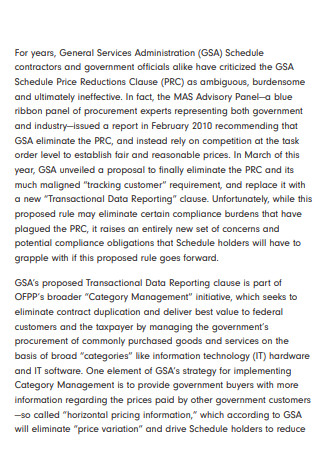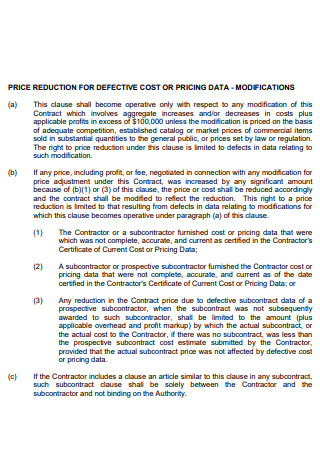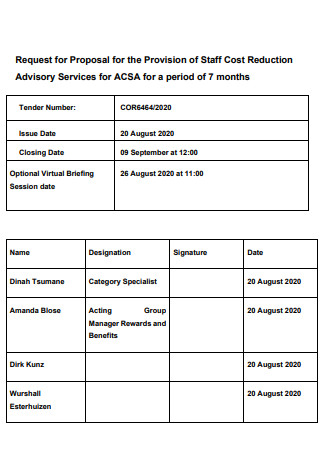3+ SAMPLE Price Reduction Proposal
FREE Price Reduction Proposal s to Download
3+ SAMPLE Price Reduction Proposal
What Is a Price Reduction Proposal?
What Is Importance of Price Reduction?
What Are the Four Rules for Price Reduction Proposal?
How Can I Determine a Fair Price Point?
How to Market a Price Cut the Right Way?
FAQs
Why Is Price Reduction a Good Idea?
Will Lowering Your Prices Increase Profits?
What Are the Pricing Strategies?
Calculating the right price is one of the trickiest parts of a business. However, there is good news—a successful price proposal is not always about what you charge, but also how you present your prices.
What Is a Price Reduction Proposal?
A price reduction proposal is a contractor’s preliminary bid for the price for a potential customer’s job. It is a document that identifies a single price the contractor will charge after calculating the potential costs they will incur as a result of completing the customer’s project. Moreover, it is important to bear in mind that a price proposal is not an estimate. An estimate is a rough, educated guess about how much a project would potentially cost a prospect. A price proposal is a detailed document containing accurate quotes for the price of raw materials, labor, taxes, and other general overhead.
Besides, it also features a contractor’s proposed markup and is often submitted in competition with other contractors vying for the same job. Ideally, a price proposal is thorough and comprehensive in covering any potential costs that may arise throughout the course of completing the project. It should also strike a balance between value for the customer and financial feasibility for the contractor. As a contractor, you want to be able to demonstrate every cost you detail in the proposal is valuable and relevant to your prospect’s needs. In some cases, you might have to offer a competitive deal or rely on an exceptional reputation to differentiate yourself from the competition. At the same time, your price proposal still needs to be worth it for you. Do not drastically undersell yourself for a contract that ultimately won’t be worth your time financially. Understand your customers’ budget and see if a potential contract is viable for you or your company.
What Is Importance of Price Reduction?
The idea of scoring a deal makes people feel as though they beat the system; however, your price is the exchange on the value you provide, so you need to tread cautiously when discounting. Let’s dive deeper:
Reduces the Activation Energy. By offering a discounted price, customers do not have to think too hard when making the decision to buy your product. Having a discount reduces the activation energy for the user to sign up by allowing them to try the product until they are ready to commit.
Can Close Deals. Deals that are on the fence may be saved by offering the prospective customer a discount, so discount pricing is a simple way to increase sales. This should not become the norm for all sales efforts, but it could be helpful when trying to close that one deal.
However, on the other hand, employers or companies tend to know the disadvantages. For instance:
Decreased Willingness to Pay. Willingness to pay goes down for users who came on with a discount. When offered a discount right off the bat, upselling them on other products is a lot more complicated. Additionally, customers who started with a discount won’t be too happy when that discount is eventually removed and they are forced to pay full price (which takes us to my next point: churn). This reduces the likelihood of them becoming repeat customers.
Higher Churn. Discounted customers have more than double the churn rate than those who weren’t given a discount, so giving may shorten the average customer lifecycle. Oftentimes, discounts bring in new customers who only make one purchase. If you look at the graph below, which is broken down by the level of discount, you’ll notice a strong correlation of churn increasing as the discount level increases.
Impacts Growth. Part of the reason we love a recurring revenue model is because we can predict growth. However, once you start discounting, it becomes increasingly complicated to predict as your value proposition is compromised and customer loyalty is not consistent across your customer base. Customers that are acquired with a discount are more likely to churn, but it’s more difficult to know when they will do so, making growth unpredictable.
What Are the Four Rules for Price Reduction Proposal?
With the impact of pricing in mind, here are the important rules for pricing a proposal:
How Can I Determine a Fair Price Point?
When it comes to pricing products, you have a dozen ways to crunch the numbers. But depending on your industry, it may take some trial-and-error to land on the best strategy. Here are three common ways to compute the right price.
Value-Based Pricing
One of the best ways to gauge your potential price point is through value-based pricing. It’s a pricing strategy used by businesses to price products and services at a rate that they believe consumers will be willing to pay. A value-based pricing model doesn’t just consider production costs with a fixed markup tacked on. Getting a feel for that figure can be a difficult process. It takes customer analysis, competitive analysis, and market research to really nail down what you should be charging for a particular service.
Competitive Pricing
As the name suggests, competitive pricing involves setting prices relative to those of your competition. Once you know what they’re charging, you can set lower, similar, or slightly higher prices in response. If you opt to sell at a higher price than the competitors, make sure it can be justified in some way—whether that’s with a money-back guarantee or a higher-quality product or service.
Cost-Plus Pricing
Cost-plus pricing is one of the simplest ways to determine prices, and many businesses use it as their primary pricing strategy. It focuses on the cost of producing your goods or services (COGS). With this method, apply a fixed percentage to your production or service cost when calculating prices. Another disadvantage is that it doesn’t factor in the customer’s willingness to pay or the perceived value of your products. These are two important influences to consider when setting prices.
How to Market a Price Cut the Right Way?
Marketing effectively and efficiently is always difficult, but things can get particularly thorny with price cuts. To get the word out on your company’s new payment model, try these tactics.
Step 1: Make it Cohesive
A price cut is never just a price cut. A business that drops its prices out of the blue with nothing more than an announcement signals something it doesn’t want to. Perhaps its product has dipped in quality, or its customers have moved to better alternatives. In any case, it’s best not to leave customers wondering why your prices suddenly dipped. The best way of going about it is not by thinking about it as a price cut but as a complete rebranding. Unjustified price cuts can trouble customers or, perhaps even worse, go unnoticed entirely. Selling your price reduction as part of a larger marketing campaign ensures that it grabs attention and justifies its new price point.
Step 2: Focus on Features
Along those same lines, think of your product’s price as a key element of the marketing process. Far too often, marketers think of price as something separate from the product itself, but consumers don’t. For lots of customers, price is a feature just like any other — and you should market it that way. If your company’s primary service lost a key feature, your customers would be justified in seeing it as a depreciation in quality as well. This same principle can apply to changes in price. Emphasize your new price instead of emphasizing the decrease.
Step 3: Establish a Timeframe
Price cuts should never happen spontaneously or without careful planning. Having a long-term plan for your product’s price is absolutely crucial. Before creating a plan, you need to understand exactly where you’re at in your product’s life cycle. Different products have different schedules for typical price drops. It’s important to know exactly how your price is following or straying from that schedule.
Step 4: Keep Your Competitors in Mind
Customers will always be looking to your competition to see how your prices and products square against theirs. If your price cut is a response to a similar one in your industry, people will take notice. To market a price cut properly, you need to emphasize the factors that make it unique. No business wants to appear one step behind the competition. Emphasize the advances in technology or boosts in your supply chain that have allowed you to cut prices, or mention that you’re hoping to give customers the best possible per-dollar value. No business is likely to come out of a pricing war on top, so be sure to stand apart from your competition whenever possible.
FAQs
Why Is Price Reduction a Good Idea?
It can temporarily improve cash flow. It’s a good way to introduce a new product faster, and to a wider audience. It can create a quick burst of sales during slow times. It’s a simple way to get rid of excess inventory or discontinued items.
Will Lowering Your Prices Increase Profits?
Let’s assume your costs remain the same, lowering prices to increase sales also lowers the profit margin you make on each unit that you sell. On the other hand, much of the time lower prices will lead to higher sales volumes, which may make up for the lower profit margin.
What Are the Pricing Strategies?
These are the four basic strategies, variations of which are used in the industry. Apart from the four basic pricing strategies—premium, skimming, economy or value and penetration—there can be several other variations on these. A product is the item offered for sale.
Discounting strategies also create a sense of urgency that might drive more customers to convert. People are drawn to lower prices because consumers love feeling as if they are scoring a good deal. Everyone enjoys getting a good discount. But, while offering discounts may make customers feel good about purchases made, it’s not always the best customer acquisition strategy for certain businesses. Data suggests using unnecessary discounts can have a negative impact on nurturing loyal customers for your business. However, discount pricing is widely used in ecommerce for good reason.




